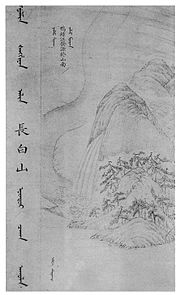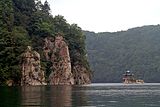| Changbai Mountains | |
|---|---|
 Aerial View of Changbai Mountains Aerial View of Changbai Mountains | |
| Highest point | |
| Peak | Mount Paektu |
| Elevation | 2,744 m (9,003 ft) |
| Prominence | 2,593 m (8,507 ft) |
| Geography | |
  | |
| Countries |
|
| Range coordinates | 41°59′28″N 128°00′18″E / 41.991°N 128.005°E / 41.991; 128.005 |
The Changbai Mountains (simplified Chinese: 长白山; traditional Chinese: 長白山; lit. 'long white mountain') are a major mountain range in East Asia that extends from the Northeast Chinese provinces of Heilongjiang, Jilin and Liaoning, across the China-North Korea border (41°41' to 42°51'N; 127°43' to 128°16'E), to the North Korean provinces of Ryanggang and Chagang. They are also referred to as the Šanggiyan Mountains in the Manchu language, or the Great Paekdu in Korean. Most of its peaks exceed 2,000 m (6,600 ft) in height, with the tallest summit being Paektu Mountain at 2,744 m (9,003 ft), which contains the Heaven Lake, the highest volcanic crater lake in the world at a surface elevation of 2,189.1 m (7,182 ft). The protected area Longwanqun National Forest Park is located within the vicinity of the mountain range.
History

The mountain was first recorded in the Classic of Mountains and Seas under the name Buxian Shan (Chinese: 不咸山). It is also called Shanshan Daling (Chinese: 單單大嶺) in the Book of the Later Han. In the New Book of Tang, it was called Taibai Shan (Chinese: 太白山). The current Chinese name Changbai Shan was first used in the Liao dynasty (916–1125) of the Khitans and then the Jin dynasty (1115–1234) of the Jurchens.
| Changbai Mountains | |||||||||
|---|---|---|---|---|---|---|---|---|---|
| Chinese name | |||||||||
| Simplified Chinese | 长白山脉 | ||||||||
| Traditional Chinese | 長白山脈 | ||||||||
| Literal meaning | Perpetually White Mountains | ||||||||
| |||||||||
| Korean name | |||||||||
| Chosŏn'gŭl | 장백산맥 | ||||||||
| Hancha | 長白山脈 | ||||||||
| |||||||||
| Manchu name | |||||||||
| Manchu script | ᡤᠣᠯᠮᡳᠨ ᡧᠠᠩᡤᡳᠶᠠᠨ ᠠᠯᡳᠨ | ||||||||
| Romanization | Golmin šanggiyan alin | ||||||||
The range represents the mythical birthplace of Bukūri Yongšon, ancestor of Nurhaci and the Aisin Gioro imperial family, who were the founders of the Qing dynasty of China. The Chinese name literally means "Perpetually-White Mountain Region". The imperial family regarded the mountain as their traditional homeland.
The Qing emperor Hong Taiji claimed that their progenitor, Bukūri Yongšon (布庫里雍順), was conceived from a virgin birth. According to the legend, three heavenly maidens, namely Enggulen (恩古倫), Jenggulen (正古倫) and Fekulen (佛庫倫), were bathing at a lake called Bulhūri Omo near the Changbai Mountains. A magpie dropped a piece of red fruit near Fekulen, who ate it. She then became pregnant with Bukūri Yongšon. However, another older version of the story by the Hurha (Hurka) tribe member Muksike recorded in 1635 contradicts Hongtaiji's version on location, claiming that it was in Heilongjiang province close to the Amur river where Bulhuri lake was located where the "heavenly maidens" took their bath. Nowadays the famous Yabuli Ski Resort is located in the Changbai Mountains.
Geography and climate
The mountains are the source of the Songhua, Tumen, and Yalu Rivers.
The Changbai Mountains are characterized by long, cold winters. Precipitation is low in winter, but higher in the summer and fall, with annual averages reaching as high as 1,400 millimeters (55 in).
Flora and fauna
The vegetation of the mountain slopes is divided into several different zones. At the top, above 2,000 meters (6,562 ft), tundra predominates. From 1,700–2,000 meters (5,577–6,562 ft), vegetation is dominated by mountain birch and larch. Below this zone, and down to 1,100 meters (3,609 ft), the dominant trees are spruce, fir, and pine. From 600–1,100 meters (1,969–3,609 ft), the landscape is dominated by mixed forest consisting of Amur linden (Tilia amurensis), pine, maple, and elm. Further down, a temperate hardwood forest is found, dominated by second-growth poplar and birch. There are five known species of plants in the lake on the peak, and some 168 have been counted along its shores. The forest on the Chinese side is ancient and almost unaltered by humans. Birch predominates near the tree line, and pine lower down, mixed with other species. There has been extensive deforestation on the lower slopes on the North Korean side of the mountain.
The area is a known habitat for Siberian tigers, bears, wolves, and wild boars. The Ussuri dholes may have been extirpated from the area. Deer in the mountain forests, which cover the mountain up to about 2,000 meters (6,600 ft), are of the Paekdusan roe deer kind. Many wild birds such as black grouse, owls, and woodpecker are known to inhabit the area. The mountain has been identified by BirdLife International as an Important Bird Area (IBA) because it supports a population of scaly-sided mergansers.
Gallery
-
 Sanjiaolong Crater Lake in the Longwanqun National Forest Park, Huinan County
Sanjiaolong Crater Lake in the Longwanqun National Forest Park, Huinan County
-
 Entrance gate to the forest park
Entrance gate to the forest park
-
 Painting from the Manchu Veritable Records with the names of Mount Paektu in Manchu, Chinese and Mongolian
Painting from the Manchu Veritable Records with the names of Mount Paektu in Manchu, Chinese and Mongolian
See also
References
- Second Canonical Book of the Tang Dynasty. 《新唐書.北狄渤海傳》:"契丹盡忠殺營州都督趙翽反,有舍利乞乞仲象者,與靺鞨酋乞四比羽及高麗餘種東走,度遼水,保太白山之東北,阻奧婁河,樹壁自固。" (English translation: Khitan general Li Jinzhong killed Zhao Hui, the commanding officer of Yin Zhou. Officer Dae Jung-sang, with Mohe chieftain Qisi Piyu and Goguryeo remnants, escaped to the east, crossed Liao River, guarded the northeast part of the Grand Old White Mountain, blocked Oulou River, built walls to protect themselves.)
- "Records of Khitan Empire". 《契丹國志》:"長白山在冷山東南千餘里......禽獸皆白。"(English translation: "Changbai Mountain is a thousand miles to the southeast of Cold Mountain...Birds and animals there are all white.")
- "Canonical History Records of the Jurchen Jin Dynasty". 《金史.卷第三十五》:"長白山在興王之地,禮合尊崇,議封爵,建廟宇。""厥惟長白,載我金德,仰止其高,實惟我舊邦之鎮。" (English translation: "Changbai Mountain is in old Jurchen land, highly respectful, suitable for building temples. Only the Changbai Mountain can carry the Jin Dynasty's spirit; It is so high; It is a part of our old land.")
- 愛新覺羅·瀛生《滿語口語音典》
- Crossley, Pamela Kyle (February 2000). A Translucent Mirror: History and Identity in Qing Imperial Ideology. University of California Press. p. 202. ISBN 9780520234246.
- The Chinese state at the borders. Vancouver: UBC Press. 2007. ISBN 978-0-7748-1333-4.
- Pamela Kyle Crossley (15 February 2000). A Translucent Mirror: History and Identity in Qing Imperial Ideology. University of California Press. pp. 198–. ISBN 978-0-520-92884-8.
- Huang, Pei (1990). "New Light on The Origins of The Manchus". Harvard Journal of Asiatic Studies. 50 (1): 239–282. doi:10.2307/2719229. JSTOR 2719229. Archived from the original on 2020-08-07. Retrieved 2020-11-05.
{{cite journal}}: CS1 maint: bot: original URL status unknown (link) - Yabuli • Ski Holiday • Reviews • Skiing - Snow-Online
- "Changbai Mountains -- Scenic Wonderland". China.org.cn. Retrieved 12 July 2014.
- "Changbai Mountains mixed forests (PA0414)". WildWorld Ecoregion Profile, National Geographic Society. World Wildlife Fund. Archived from the original on 2010-03-08. Retrieved 9 February 2015.
- Liu, Q.J., Takamura, T., Takeuchi, N., Shao, G. (2002). Mapping of boreal vegetation of a temperate mountain in China by multitemporal LANDSAT imagery. International Journal of Remote Sensing 23(17), p. 3388
- Gomà Pinilla, D. (2004). Border Disputes between China and North Korea. China Perspectives 2004(52): 1−9.
- "Mount Paekdu". Important Bird Areas factsheet. BirdLife International. 2013. Retrieved 2013-05-12.
External links
- Baekdu mountain at changbaimountain.com Archived 2018-10-03 at the Wayback Machine
| Mountain ranges of China | |
|---|---|
| Geography of China | |
| Northwestern | |
| Qinghai-Tibet and Southwestern | |
| Northeast | |
| North and East | |
| Central | |
| South | |
| Jilin topics | |
|---|---|
| Changchun (capital) | |
| General | |
| Geography | |
| Education | |
| Culture | |
| Visitor attractions | |
| Liaoning topics | |
|---|---|
| Shenyang (capital) | |
| General | |
| Geography | |
| Education | |
| Culture | |
| Visitor attractions | |
| Heilongjiang topics | |
|---|---|
| Harbin (capital) | |
| General | |
| Geography | |
| Education | |
| Visitor attractions | |